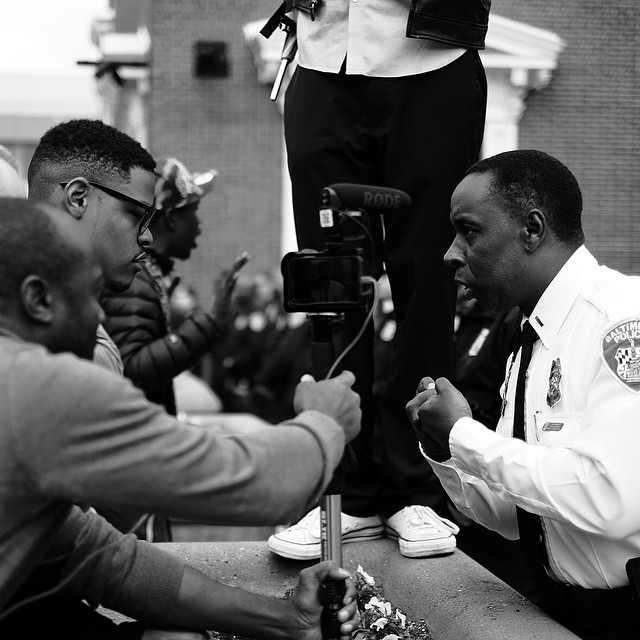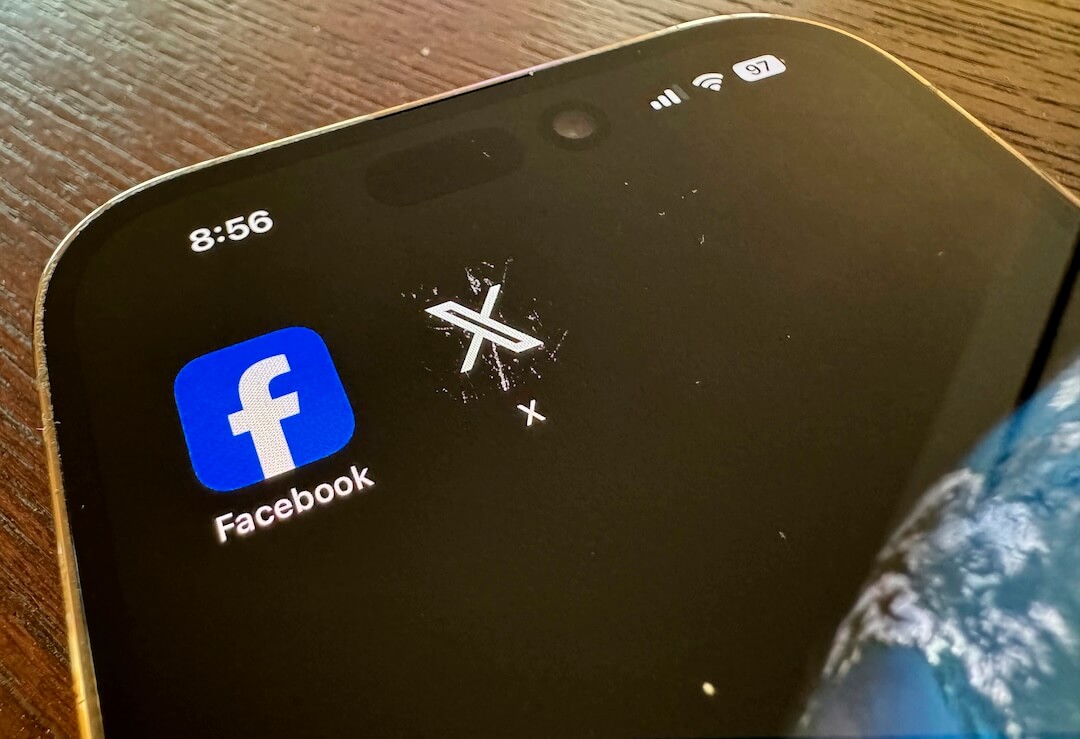
AJ+ producer Damu Bobb uses a mobile rig to report from Baltimore. Photo by Devin Allen)
I came to AJ+, Al Jazeera’s new social media and app-first unit, last summer after spending several years reporting on the revolution in Egypt. In Cairo, mobile phones were the primary method of sharing news from the street. At protests you’d see dozens of hands in the air, recording on everything from flip phones to iPhones. Soon after joining AJ+, I was deployed to Ferguson, where tweets and Vines by protestors scooped media on social platforms. We joined in.
This past week, as protests first erupted into clashes in Baltimore, we replicated our “mobile army” model with a two-person mobile reporting team that my co-producer Katrine Dermody and I directed from our San Francisco office. Our producers Dariel Medina and Damu Bobb livestreamed and delivered breaking content that we published immediately to Twitter, Facebook and Youtube – breaking our previous records for engagement and increasing our audience numbers in the tens of thousands.
So, how did this happen? My simple answer always is: Mobile reporting is the future of breaking news. The longer answer is: Mobile reporting offers the opportunity to engage directly with the social media audience – i.e. our target millennial viewership – unfiltered and in real-time. The reason much of our Baltimore content went viral had to do with these main factors: 1) Relevance; 2) Timing (immediate delivery on social platforms); 3) Conforming to social norms/standards (the sharing audience members raised their social profile by associating themselves with the content first); 4) Raw emotive video.
The last point is key. We understand that viral content has predictable qualities: It elicits an emotional reaction – at best, great emotional arousal. We know that positive emotions often carry content farther than negative (awe vs. sadness), and anger-inducing content is more likely to be shared than sadness-inducing; it produces greater emotional activation. Knowing this, I’m aware of emotive moments in the field, and I ask my producers to do the same. On social media Wednesday, it was not Geraldo Rivera’s reporting that went viral, but raw video a reporter captured of a local man schooling Geraldo on FOX’s reporting. It was shared with celebratory commentary: “Love this.” “Real talk.” (Noting of course that media bashing the likes of FOX or CNN is an easy “win” on social media).
Our team arrived in Baltimore early Friday, April 24. They filmed the first major march on iPhones and sent raw clips immediately back to us in San Francisco using the real-time messaging service Slack (one of the greatest tools at our disposal). Katrine and I would then trim short pieces into even shorter bites, bug them with the AJ+ logo and share on social media. Those photos and videos did fairly well. As the crowd made its way to City Hall, I received a call from Damu alerting me that Dariel would be jumping out of the car to capture a melee that had erupted near the ballpark: Punches and projectiles were being thrown, windows and cars were being smashed.
Minutes later, his footage began coming in. It appeared that only Dariel and a few photographers and perhaps protestors or bystanders were capturing the scene. Katrine quickly pushed to Twitter this video of a man in a “The Punisher” t-shirt standing between police and protestors, urging: “Do not give them a reason!”
#FreddieGray protester: "Listen to me! Do not give them a reason!"
https://t.co/chgy7Uo9f7
— AJ+ (@ajplus) April 26, 2015
The image of one man acting as a peacemaker amid chaos activated the emotions that drive viral sharing. It was shared on Twitter with commentary like, “They are not showing this on the news.” Meanwhile on Facebook, I posted a 38-second video with cuts of the melee that ended with “The Punisher” man. That video went viral. Because Facebook allows for context in a description, I was able to address the hysteria erupting on social media by noting “Most #FreddieGray protesters in #Baltimore have been peaceful. But some near the stadium…” Still, it appears many initially shared the video because of the shock value of the chaos. While others, and future sharers, did so in order to highlight “Do not give them a reason” man.
During Freddie Gray’s funeral on Sunday, April 25, we used Stringwire to livestream. It was routed to broadcast on our Youtube channel. Here’s where we ran into major technical difficulties. One of the biggest challenges with mobile reporting and livestreaming is reliance on mobile networks. When there’s a large number of people in a space, the network overloads and data rates drop. In Ferguson we sometimes had to run or drive away from crowds to transmit full HD footage. Carriers are everything. In Ferguson, Verizon worked best and Sprint failed every time. The same was true in Baltimore. We retained a modest audience during the livestream, but dropped coverage so many times that I had to keep people engaged by answering their questions on chat.
The next time we livestreamed we used Periscope instead, which our producer preferred. We had so many chatting on screen at one time that people’s faces were covered by comments. But it was much smoother technically. Our mobile reporter appreciated the feedback and fielded questions from the viewers:
Other issues you can face while mobile reporting: Weather, audio and quality. In Ferguson we reported in pouring rain and later snow. Our lenses would fog and there are no coverings to protect makeshift mobile reporting set-ups. We had to use garbage bags. There’s no way to monitor sound with the iPhone’s native camera app. And quality is a big gripe brought up most as an argument against mobile reporting by those who love DSLR’s. Don’t get me wrong, I do, too. But while mobile footage can be shaky, the colors are less than gorgeous and the sound isn’t great, the story remains the same. And the delivery is immediate. That’s what’s important. And in the calm between the chaos, we found ways to report unique angles – Gangs uniting over Freddie Gray’s death in Baltimore, or how activists were using instructions from Palestine to make gas masks out of soda bottles in Ferguson.
Not surprisingly, however, our most popular videos are the quick hits amid protests.
At AJ+ we deliver our news solely on social media and mobile platforms, so it’s only natural that we also capture breaking news with mobile phones. While there are many who dismiss the low quality, I’m in the camp that believes the social media audience appreciates raw video — despite the quality — because there’s a layer of trust built when there’s no editing. In fact, a comment below the viral Facebook video of the melee dismissed the footage because it had been strung together, calling it “highly edited.” Breaking news is one instance in which speed trumps quality, particularly when your audience is also citizen reporting on social media and has trust invested in raw video.
As a journalist, if you’ve ever chased protests with television cameras or a DSLR while also tweeting as I have – the size and weight of a mobile phone rig is liberating. Our teams move nimbly, capturing shots over crowds by extending the monopod over heads. We edit directly on the camera app, trimming video to capture the exact sound bites we want our team to use, eliminating the need for scripts and circumventing mistakes. And it is a clear advantage to be able to blend into crowds without changing the mood or tenor, reporting almost invisibly in order to capture authentic scenes in a way that Geraldo or Anderson Cooper cannot.
Before I left Egypt, I saw a call-out in Cairo for mobile documentaries. After reporting with a mobile phone in Ferguson, and now producing a team in Baltimore, I am now working with my cohorts to brand a “mobile army” model— a mobile reporting force ready to be deployed to report breaking news and produce mini-documentaries easily and efficiently around the world. At AJ+ we’re incorporating this strategy as one of the many tools necessary to deliver news to our audience and increase our online engagement.
I’ve been asked often whether I believe mobile phones will replace legacy journalism – most often by weary peers. I do not. But I do believe that a mobile journalism kit should be at every journalist’s disposal. Communicating directly with the social media audience is the future of journalism — eliminating the top-down approach to news. Now is the time for all in media to embrace it fully, and help move the technology forward.








Comments